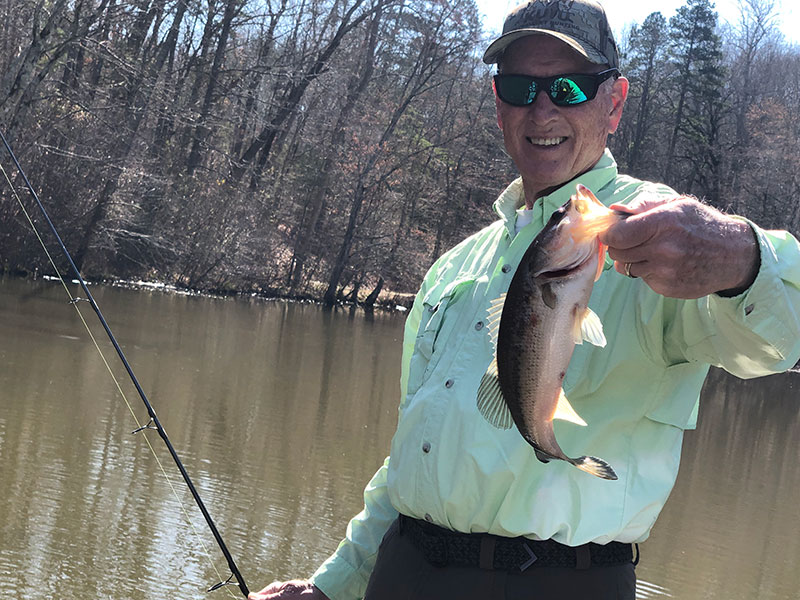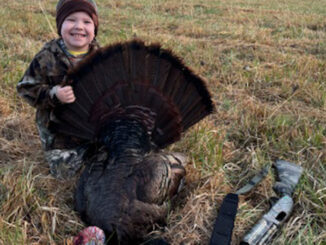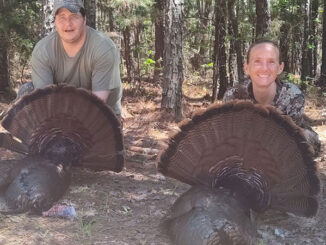
When a bass fisherman talks about a “transition month,” that usually means the fishing is tough, because the fish are moving so much, they’re difficult to keep up with.
Well, May is certainly a transition month, but you won’t find many fishermen who complain, because it can be a great month in the Carolinas.
It depends somewhat on the weather, but a lot of fish will be in post-spawn by the end of the month, maybe 90%. There may be some late spawners in lakes along the North Carolina-Virginia border, but across the rest of both states, fish will be finished with the spawn.
You start May off with a good topwater bite in the morning, then you go to a small crankbait, maybe a Dredger 10.5, for fish in 7 to 9 feet of water. As each week goes by, the fish will move 3 to 5 feet deeper. It’s a big move, but it’s one you can follow.
At Lake Wylie and in most of the lakes across South Carolina, the spawn will be done by early May. They’re going to move out of their spawning pockets to 10 to 12 feet of water, and by the end of May, they’re going to be pretty close to where they’re going to live all summer, 12 to 18 feet deep.
Rocky month
The key to finding them is knowing that when they leave spawning pockets, they’re going to stop on corners, little rocky points. Fish love rocks in May. All spring, rocks are the kind of structure where bass will hold. Anywhere you have little patches of rock, you’ll have little patches of fish. If they’ve spawned by May 1, they’ll start ganging up by mid-May. So you can find them in little groups of five to 10 fish on a spot. That’s great, but it’s nothing like it used to be, where you could catch 20 or 30 on a spot.
They’re going to be on places like rocks and hard bottoms in May – they won’t get on wood until June – but they’ll also be next to edges, nice drops, because they’re going to be moving out in spurts. Every week, when they move deeper, you just throw a deeper-diving crankbait.
Later in May, they’re going to be as aggressive as they’ll be at any time of the year. You can really wind your bait fast. If you catch one on a spot, you can slow down a little bit and try to catch all of them.
Because they’re around rock, crawfish colors are going to be really good. Chartreuses can be excellent, especially chartreuse/brown. I really like that mustard color if the water isn’t clear. I like to fish Old Blue, Kentucky Blue and Honey Shad if the water is a little stained. Either way, you’re moving from crawdad colors to shad colors as the month progresses.
Staggered fish
A good thing to know is that, just like the spawn shows up earlier in some parts of a lake than the others, the move back out to deep water will also be at different times in different areas. In certain parts of a lake, the fish might be moving out a week or two ahead or behind. On my home lake, High Rock, they start out first in Flat Swamp, the creek closest to the dam. They’ll bite good there for a week, then the fish in Second and Abbotts creeks start to move, then the fish in Swearing Creek and the river. They move out first on the lower end – just like the spawn earlier.
One thing that can throw off this schedule is high water. If the water is up from a big storm, if the water’s in the shoreline trees and bushes, that’s going to slow down their move to deeper water. At Buggs Island, even in June, if the water is 3 feet up in the bushes, that’s where the fish are going to be. If the water is high enough that they can get on shallow wood, they’ll be out looking for deeper stumps and rocks.
Dirty water can also slow things down. They’ll stay shallow longer in dirty water. But if the water is clear and the level normal to a touch low, they’ll be moving.
One thing that’s very big this time of year is current. If the people who are running the dams are pulling water and setting up a current, those fish that have moved out are really going to bite. When you notice that the water is being pulled, that’s the time to be on your best spots, because that current is moving bait into areas where bass are waiting in ambush.
While you can have great success following fish as they move into the shallows in March and April, it can be just as good following them as they move out in late spring – plus, they’re hungry after recovering from the spawn.
Keep moving:
Every week throughout the month of May, bass will move a little bit deeper, as long as the lake you’re fishing isn’t flooded. Start the month fishing relatively shallow water, and ease out to deeper water with every outing.





Be the first to comment